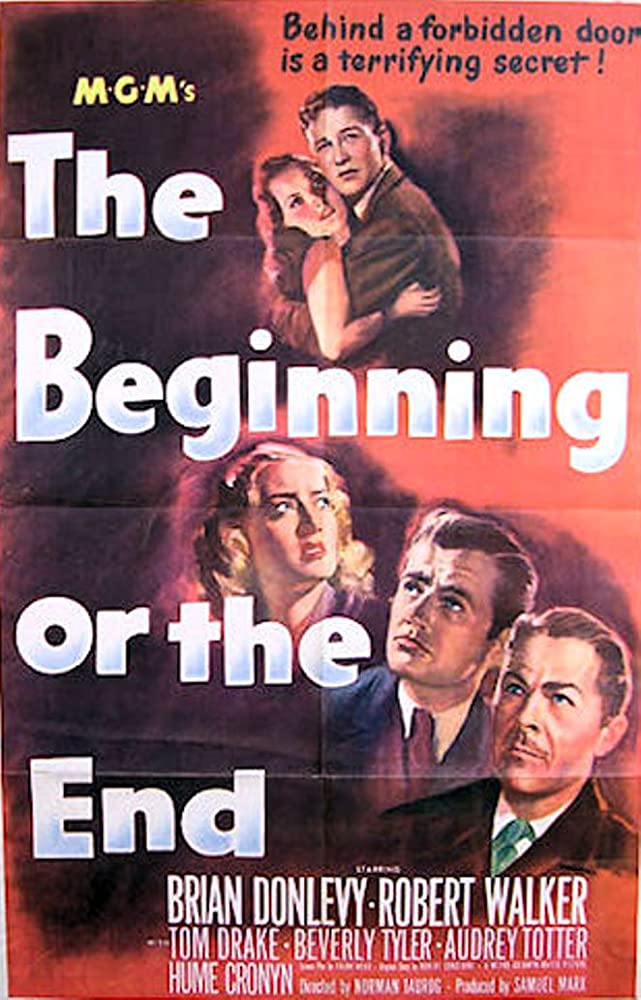The Beginning or the End
by Rob - May 19th, 2020.Filed under: Oppenheimer Alternative.

We spent an interesting evening watching the 1947 movie The Beginning Or The End, which was the first-ever dramatic treatment of the Manhattan Project (the subject, in part, of my new novel The Oppenheimer Alternative, coming out two weeks from today).
Overall, the film ranges from charmingly earnest to sappily sentimental to just this side of propaganda. But, that said, I quite enjoyed it. J. Robert Oppenheimer is a minor character in the film, affably portrayed by the Canadian actor Hume Cronyn, the first person ever to portray Oppenheimer in any medium.
The film’s star is Brian Donlevy, playing General Leslie R. Groves, and he does the character credit. (Donlevy went on to portray Professor Bernard Quatermass in the movie version of The Quatermass Xperiment).
The second and third leads are Robert Walker (the father of the actor of the same name who played in the classic Star Trek episode “Charlie X”) and Tom Drake.
Walker plays a version of Groves’s right-hand-man Kenneth Nichols so fictionalized that they had to change his name to “Nixon.” And Drake plays a wholly fictitious character, whose romance with his new bride (a stunningly beautiful Beverly Tyler) is tacked on as “human interest” that the film really doesn’t need, although the actors are pleasant enough.
The film gave to Drake’s character the story of Canadian physicist Louis Slotin, who accidentally triggered criticality and saved others at the cost of his own life. That event that actually happened in May 1946 in Los Alamos, but the filmmakers move it to August 1945 and Tinian airbase just hours before the Enola Gay takes off from there to obliterate Hiroshima.
The movie does do a good job of showing people conflicted about their work on the bomb and has a nice (but wholly fictitious, as far as I can tell) bit with a Quaker and two other scientists giving their resignations to Enrico Fermi after the Stagg field atomic-pile test because of their pacifist beliefs.
But the film out-and-out lies about the people of Hiroshima having been warned by an air-drop leaflet campaign for ten days leading up to the bombing of Hiroshima so that they could safely evacuate. As the review in the March 1947 Bulletin of the Atomic Scientists says, this was “the most horrible falsification of history” in the movie.
Unlike so many of the American fictional treatments of the Manhattan Project, this film repeatedly gives Canadians (and the Brits!) their due, with an actor portraying C.D. Howe, Canada’s Minister of Munitions and Supply.
I spotted an uncredited John Hamilton (later Perry White of the 1950s Superman TV series) as Harold Urey. The recreated bomber sequences involving the Enola Gay and its two companion planes — which seemed to be done with a trio of actual bombers, rather than miniatures — are really well done, as are the atomic-blast sequences.
The movie is available from Warner Archive, and the print and the transfer is as clean and crisp as one could hope for from a film this old that hasn’t undergone a clean-up restoration.
The one special feature is the theatrical trailer — and that must be seen to be believed. Rather than scenes from the movie, it consists of supposed interviews with movie-goers on preview night (all of who are actors in scripted parts, it seems) praising the movie to the skies and debating in measured tones the wisdom of atomic energy. The trail over the top; stunningly so.
Robert J. Sawyer online:
Website • Patreon • Facebook • Twitter • Email

